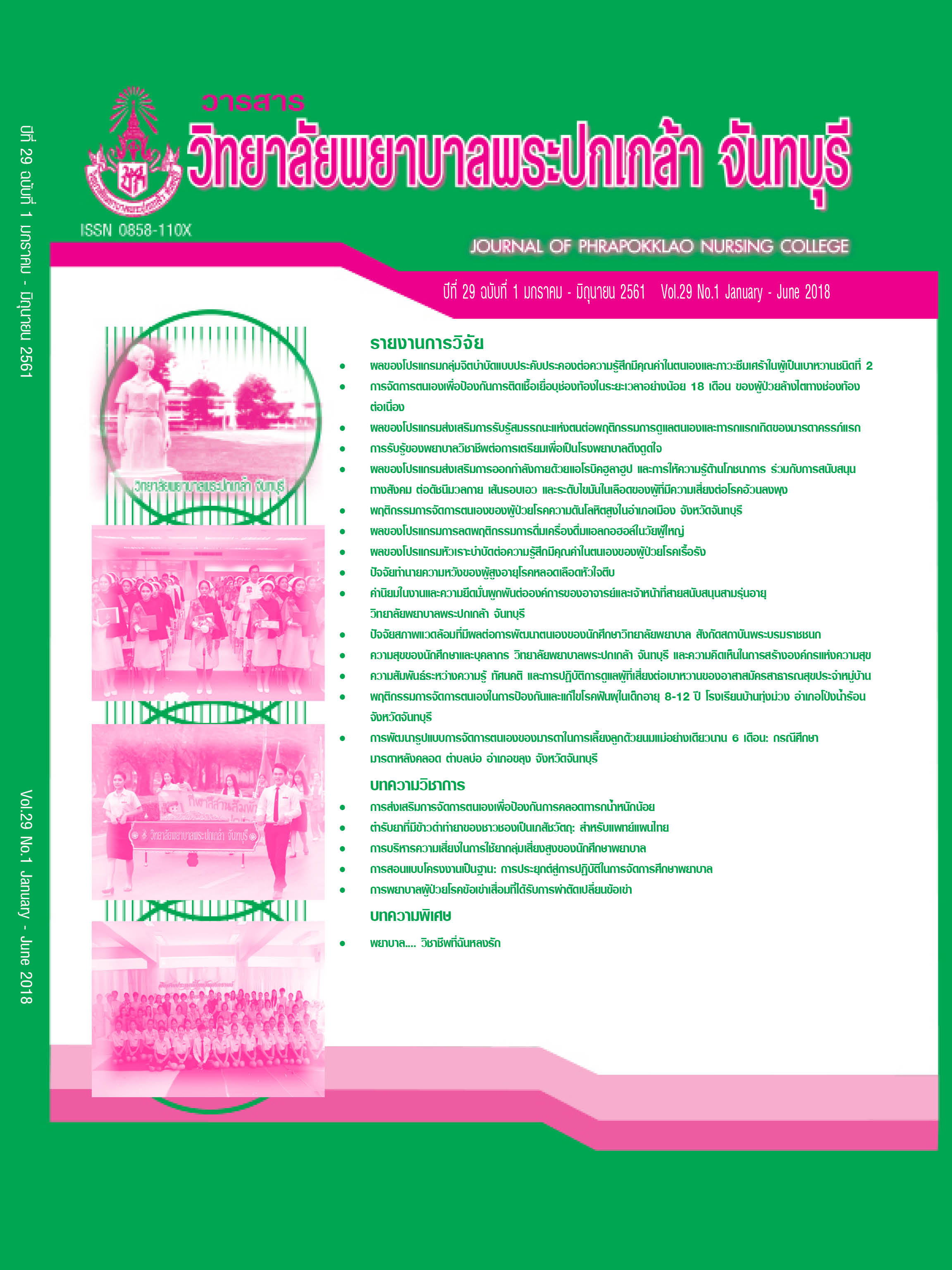The Effects of Supportive Group Psychotherapy on Self-esteem and Depression of Persons with Type 2 Diabetes
Keywords:
Supportive group psychotherapy, Self-esteem, Depression, Persons with type 2 diabetesAbstract
This quasi-experimental research aimed to examine the effects of supportive group psychotherapy on self-esteem and depression of persons with type 2 diabetes. The samples consisted of 24 persons with type 2 diabetes receiving services at diabetic clinic, out patient department, Wangchan Hospital, Rayong Province and were equally divided into an experimental group (n = 12) and a control group (n = 12). The research instruments included supportive group psychotherapy, a questionnaire of demographic data, the Self-esteem Inventory with the reliability of .83, and Beck Depression Inventory with the reliability of .84. The implementation and data collection were conducted from September 14 to November 30, 2015. Statistics used for data analysis included frequency, percentage, mean, standard deviation, Chi-square test, independent t-test, two-way repeated measure ANOVA, and repeated measure ANOVA with multiple comparisons by Bonferroni.
The research results revealed that: 1) at post-test stage, the experimental group had statistically significant higher mean score of self-esteem and lower mean score of depression than the control group (F = 23.560, p < .001 and F = 38.920, p < .001, respectively); 2) at 1-month follow-up stage, the experimental group had statistically significant higher mean score of self-esteem and lower mean score of depression than the control group (F = 42.420, p < .001 and F = 63.460, p < .001, respectively); and 3) in the experimental group, the mean scores of self-esteem and depression at pre-test stage, post-test stage, and 1-month follow-up stage were statistically significantly different (p < .001).
This research suggested that health care providers should apply this supportive group psychotherapy to enhance self-esteem and reduce depression among persons with type 2 diabetes.
References
เกสร มุ้ยจีน, มรรยาท รุจิวิชชญ์, และชมชื่น สมประเสริฐ. (2555). ผลของโปรแกรมการผ่อนคลายกล้ามเนื้อแบบก้าวหน้าร่วมกับกลุ่มจิตบำบัดแบบประคับประคองต่อระดับความซึมเศร้าของผู้สูงอายุที่ป่วยด้วยโรคเรื้อรัง. วารสารการพยาบาลจิตเวชและสุขภาพจิต, 26(1), 19-34.
ชนัดดา แนบเกษร. (2549). เอกสารประกอบการสอนเรื่อง พยาธิสรีรวิทยาและเภสัชวิทยาเพื่อการพยาบาลสุขภาพจิตและจิตเวชขั้นสูง. ชลบุรี: ภาควิชาสุขภาพจิตและการพยาบาลจิตเวช คณะพยาบาลศาสตร์ มหาวิทยาลัยบูรพา.
ชลิยา วามะลุน, จิรังกูร ณัฐรังสี, พัชนี เทพาอภิรักษ์, และศิริลักษณ์ เงยวิจิตร. (2551). การเสริมสร้างความหวังและความรู้สึกมีคุณค่าในตนเองสำหรับผู้ป่วยมะเร็งที่มีภาวะซึมเศร้า: กรณีศึกษาศูนย์มะเร็งอุบลราชธานี. วารสารโรคมะเร็ง, 28(2), 55-63.
ดลฤดี เพชรสุวรรณ. (2548). Depressive disorder: Etiology and clinical feature. สืบค้น 24 มกราคม 2558, จาก http://www.ramamental.com/topics/int494.pdf
ประคอง อินทรสมบัติ. (2536). แนวคิดในการดูแลผู้ป่วยเรื้อรัง. วารสารพยาบาลสงขลานครินทร์, 13(4), 14-22.
ผ่องศรี ศรีมรกต. (2536). ผลของการให้คำปรึกษาแบบประคับประคองต่อการรับรู้ภาวะความเจ็บป่วย ระดับความรู้สึกมีคุณค่าแห่งตน และขวัญกำลังใจในผู้ป่วยมะเร็งปากมดลูกที่ได้รับรังสีรักษา (วิทยานิพนธ์ปริญญามหาบัณฑิต). กรุงเทพฯ: มหาวิทยาลัยมหิดล.
ภาวนา กีรติยุตวงศ์. (2546). การพยาบาลผู้ป่วยเบาหวาน: มโนมติสำคัญสำหรับการดูแล (พิมพ์ครั้งที่ 3). กรุงเทพฯ: พี. เพรส.
มาโนช หล่อตระกูล. (2550). เรื่องน่ารู้เกี่ยวกับโรคซึมเศร้า. กรุงเทพฯ: วิสุทธิ์การพิมพ์.
ลลดา พลคะชา. (2554). ผลของโปรแกรมกลุ่มบำบัดตามแนวคิดของยาลอมต่อการเพิ่มคุณค่าในตนเองของวัยรุ่นชายที่เสี่ยงต่อการติดแอลกอฮอล์ (วิทยานิพนธ์ปริญญามหาบัณฑิต). ชลบุรี: มหาวิทยาลัยบูรพา.
ลัดดา แสนสีหา. (2536). ความซึมเศร้าและความคิดอัตมโนทัศน์ในทางลบของวัยรุ่นตอนปลาย (วิทยานิพนธ์ปริญญามหาบัณฑิต). มหาวิทยาลัยเชียงใหม่.
วรัทยา ทัดหล่อ. (2554). ปัจจัยทำนายภาวะซึมเศร้าในผู้เป็นเบาหวานชนิดที่ 2 ในเขตชุมชนเมือง จังหวัดชลบุรี (วิทยานิพนธ์ปริญญามหาบัณฑิต). ชลบุรี: มหาวิทยาลัยบูรพา.
สมภพ เรืองตระกูล. (2547). ความเครียดและอาการทางจิตเวช. กรุงเทพฯ: เรือนแก้วการพิมพ์.
สำนักโรคไม่ติดต่อ กรมควบคุมโรค กระทรวงสาธารณสุข. (2556). ข้อมูลโรคไม่ติดต่อเรื้อรัง. สืบค้น 24 มกราคม 2558, จาก http://thaincd.com/information-statistic/non-communicable-disease-data.php
American Diabetes Association (ADA). (2011). Diagnosis and classification of diabetes mellitus. Retrieved January 24, 2015, from http://www.care.diabetesjournals.org/content/27/suppl_1/s5.full.pdf
Antai-Otong, D. (2003). Psychiatric nursing: Biological & behavioral Concepts. New York: Thomson Delmar Learning.
Beck, A. T. (1967). Depression: Clinical, experimental, and theoretical aspects. New York: Hoeber Medical Division.
Gibson, J. T. (1980). Psychology for the classroom (2nd ed.). Englewood Cliff, NJ: Prentice-Hall.
Kaplan, H. I., Sadock, B. J., & Grebb, J. A. (1994). Kaplan & Sadock’s synopsis of psychiatry: Behavioral sciences/clinical psychiatry (7th ed.). Maryland: Williams & Wilkins.
Primomo, J., Yates, B. C., & Woods, N. F. (1990). Social support for women during chronic illness: The relationship among sources and types to adjustment. Research in Nursing & Health, 13(3), 153-161.
Rosenberg, M. (1965). Society and the adolescent self-image. Princeton: Princeton University Press.
Yalom, I. D. (1995). The theory and practice of group psychotherapy (4th ed.). New York: Basic Book.
Downloads
Published
How to Cite
Issue
Section
License
Copyright (c) 2018 Journal of Phrapokklao Nursing College

This work is licensed under a Creative Commons Attribution-NonCommercial-NoDerivatives 4.0 International License.
เนื้อความ ข้อมูล และรายการอ้างอิงที่ผู้เขียนใช้ในการเขียนบทความเพื่อลงตีพิมพ์ในวารสารวิทยาลัยพยาบาลพระปกเกล้า จันทบุรี ถือเป็นความคิดเห็นและความรับผิดชอบของผู้เขียน คณะผู้จัดทำวารสารไม่จำเป็นต้องเห็นพ้องด้วยหรือร่วมรับผิดชอบ
บทความที่ได้รับการลงตีพิมพ์ในวารสารวิทยาลัยพยาบาลพระปกเกล้า จันทบุรี ถือเป็นลิขสิทธิ์ของวารสารวิทยาลัยพยาบาลพระปกเกล้า จันทบุรี หากหน่วยงานหรือบุคคลใดต้องการนำส่วนหนึ่งหรือทั้งหมดของบทความไปเผยแพร่ต่อเพื่อวัตถุประสงค์ใด ๆ จะต้องได้รับอนุญาตจากบรรณาธิการวารสารก่อน



